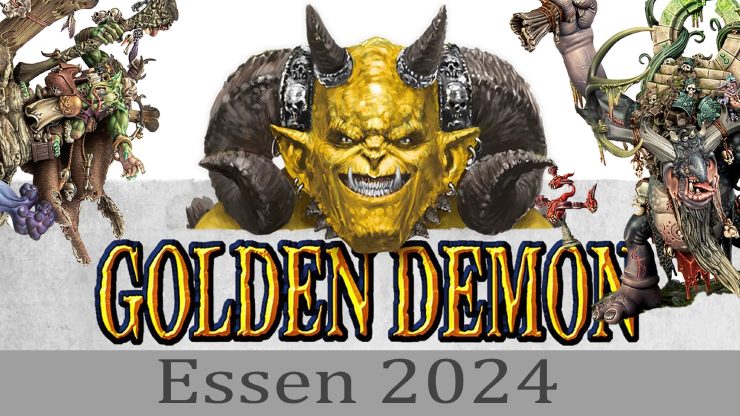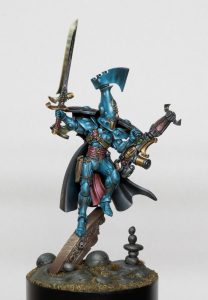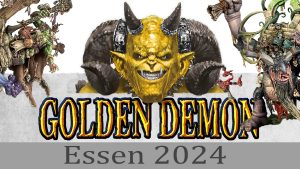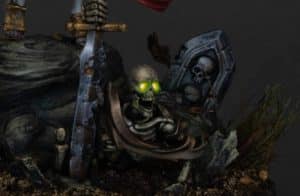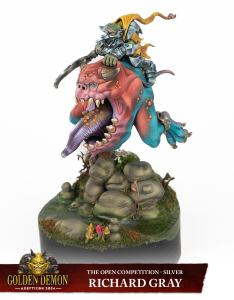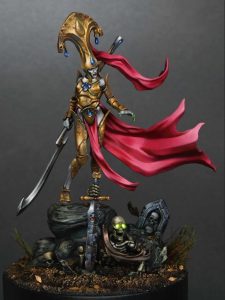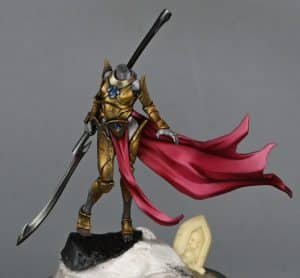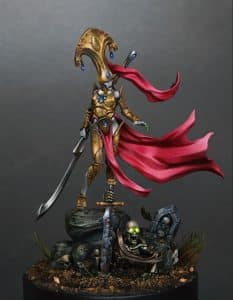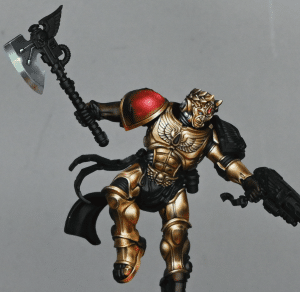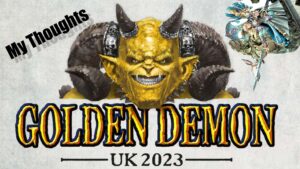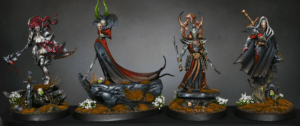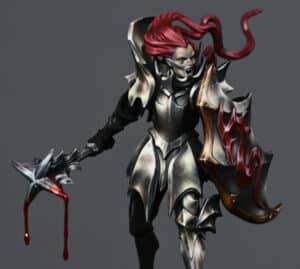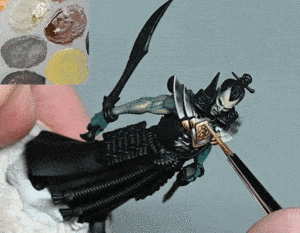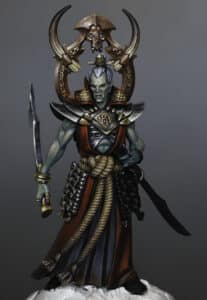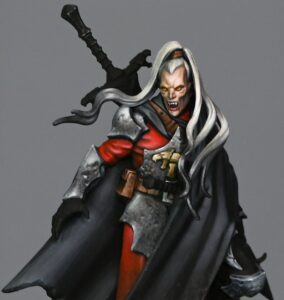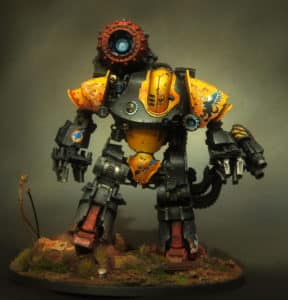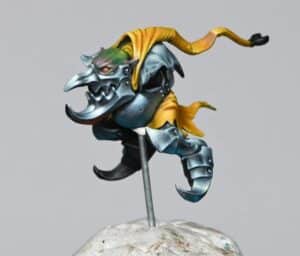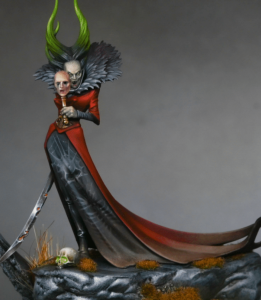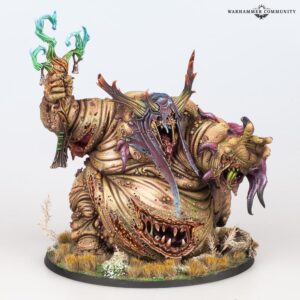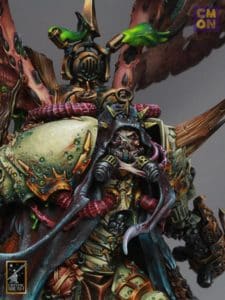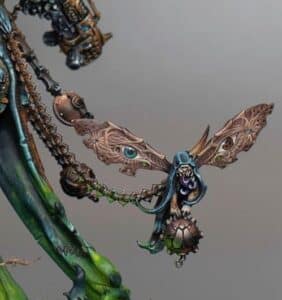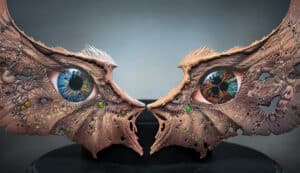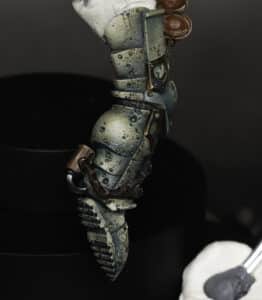The Golden Demon Essen 2024 was one of the year’s most highly anticipated Warhammer painting competitions, drawing top-tier talent from across the globe. As part of the massive Spiel trade show in Germany, this year’s event offered a chance to see some of the most beautifully painted miniatures up close and personal, with fierce competition across multiple categories. Whether you’re a seasoned painter or just an enthusiast of the Warhammer universe, Golden Demon is always an event to watch.
In the video below, I share my personal experience attending Golden Demon Essen 2024 for the first time—what it was like navigating the event, the incredible models on display, and my thoughts on everything from the lighting to the judging. Check it out, and then read on for a more detailed breakdown of the highs and lows of this year’s competition!
Video – Golden Demon Essen 2024
Golden Demon Essen 2024: My First-Hand Experience!
Hello and welcome to my latest blog! 😉 Today, I’m excited to share my experience attending the Golden Demon event at Essen in Germany. It was my first time visiting Germany, which added an extra layer of excitement to the whole experience.
Before diving in, I want to give a quick shout-out to Bruce and Alex from my Discord community, who generously contributed some extra footage and photos for this blog. Unfortunately, I didn’t manage to capture everything I wanted on my own, as I missed my window to walk around all the cabinets without the crowds. Recording became a bit tricky with the long queues, but thanks to their help, I still have plenty to share.
Spiel Trade Show: A Massive Event
The Golden Demon was held during the Spiel trade show, which is absolutely enormous, hosting tens of thousands of people. It’s much larger than something like Warhammer Fest, and if you were expecting a more Warhammer-centric event, you might have found it a little underwhelming. While Golden Demon was a major highlight, the rest of the event catered heavily to board game enthusiasts.
For those, like me, who mainly wanted to focus on Golden Demon and Warhammer, the rest of Spiel might not have been as relevant. However, if your expectations were clear from the start, there was still plenty to enjoy. Golden Demon, after all, delivered what it promised—spectacular models and the thrill of competition.
Navigating the Crowds and Set-up
The Golden Demon display cabinets were arranged in a familiar layout, typical of previous events, with models set out in a rectangle for easy viewing. However, one small issue was the overlap between the queue for handing in models and the queue for viewing the cabinets. Luckily, since the event lasted multiple days, there was no rush, and everyone had plenty of time to submit their entries without stress.
One small critique I’d make is that Games Workshop had an online model preview happening the same weekend. It would have been fantastic to see those new models in person at the event, enriching the experience even further. But, that’s just a minor point in what was otherwise an exciting event.
Lighting Woes: Still Room for Improvement
Now, let’s talk about one of the most important aspects of any Golden Demon: the lighting. If you attended Adepticon, you probably remember how the lighting there was a disaster—underlighting, lights coming from the sides, and overall inconsistency that made viewing some models a frustrating experience. At Essen, I was relieved to find that there was no underlighting this time, which was a big improvement. However, it still wasn’t perfect.
Most of my footage focuses on models displayed on the middle shelves, and there’s a good reason for that—the lighting was significantly better there. Unfortunately, the top and bottom shelves weren’t as lucky. The top shelves were placed too high, so depending on your height, you were either looking straight at the models or awkwardly up at them, and the light didn’t hit them properly. As for the bottom shelves, well, they were almost on the floor, which made it a challenge to get a proper view. It’s baffling to me that Games Workshop can’t seem to get the lighting just right for these events. A simple fix—adding lights at the top front of each shelf, angled downward—would make all the models shine as they deserve.
Judging: A Shift in Approach
One thing that stood out at this Golden Demon was the judging. For the first time, there was a guest judge, and while that was interesting, I noticed that none of the judges were from the ‘Eavy Metal team. This is a significant change from past Golden Demons, especially in the UK, where the ‘Eavy Metal team were usually the ones assessing the models. Now, I’m not here to question the quality of judging—that’s Games Workshop’s domain—but it did feel like the shift in judges led to some surprising results.
To give some context, I’ve been entering Golden Demon competitions since the ’90s, and this time, I saw several entries that, in previous years, would have easily earned trophies. However, they didn’t even receive commendations, just finalist pins. Now, I fully acknowledge that judging is subjective, and what one judge values, another might overlook. Still, it was hard not to feel that some truly outstanding pieces were overlooked in favor of others that didn’t seem quite as polished or creative.
That said, the winning entries were all fantastic, as you’d expect at a Golden Demon. But I did find it odd that so many incredible models didn’t place as high as they should have. In a competition of this caliber, you expect the judging to be razor-sharp, and while it was certainly competent, I think there’s room for more consistency.
An Overwhelming Standard: The Competition Was Fierce
One thing I absolutely cannot deny about this Golden Demon was the overall standard of the entries. To say it was high is an understatement. It’s always a tough competition, but this year, it felt like nearly every shelf was packed with exceptional work. The proportion of top-tier models to finalists and commended pieces was striking. It was almost overwhelming to walk around and see just how much effort people had put in, and it became clear very quickly that the judges had their work cut out for them.
Interestingly, this might explain why some incredible models didn’t receive the recognition they deserved. When everything is painted to such a high standard, it becomes harder to pick out those standout pieces because they don’t jump out at you the way they might in a less competitive year. In previous competitions, it’s been easier to spot the top few entries, but this time around, the quality was so evenly stacked across the board that I can see why even judges struggled.
I also noticed a few comments online from people saying things like, “If that didn’t win, why should I even bother entering?” And while I understand the sentiment, I think it’s important to remember that in a competition like this, you’re not just being judged on pure painting skill. There are so many other factors—presentation, atmosphere, the overall theme of your piece, and how well it fits within the Warhammer universe. It’s not always the most technically perfect piece that wins; sometimes, it’s the one that tells the best story or embodies the Warhammer spirit the most.
So, if you’re thinking about entering, don’t be discouraged by the fact that some truly fantastic models didn’t win. It’s all about hitting that specific combination of elements that the judges are looking for, and it can be a bit of a mystery to figure out exactly what that is from year to year.
Category Chaos: Are We Jamming Too Much Together?
Another interesting thing I noticed at this year’s Golden Demon was how the categories were arranged. They’d mixed things up a bit, especially with some of the 40K categories. For example, 40K Large and 40K Vehicle were combined, and they’d added some new categories like Horus Heresy, Underworlds, and Necromunda. While it’s nice to see some variation, the way they’ve grouped some things doesn’t always make sense.
Take Horus Heresy, for instance. That category includes single models, units, vehicles, and Titans all thrown together. Meanwhile, 40K has more distinct categories like Single Model, Unit, Large, and Vehicle. It feels a bit inconsistent, but I get that 30K is a smaller system, and if you lumped all the Horus Heresy models in with 40K, they’d probably get overshadowed. Still, it makes for some strange matchups—you might have a Primarch competing against a unit of jet bikes, which doesn’t always feel fair.
There’s also the perception that some of the smaller categories, like Blood Bowl or Underworlds, are “easier” to win in because they attract fewer entries. But let me tell you, Necromunda was one of the most competitive categories this year! The standard was so high that I’d argue it was even tougher to place in Necromunda than in some of the 40K or AoS categories. So, if anyone thought they could sneak in a quick win by entering a “less popular” category, they were in for a rude awakening.
The Open Category: What Exactly Is It For?
One area that really left me scratching my head was the Open category. Now, the Open category has always been a bit of a wildcard, but this year it seemed particularly unclear what the judges were looking for. To me, it felt like more of an “overflow” category—a place where people put their extra models when they didn’t fit into another category or had already entered something elsewhere.
Traditionally, the Open category can be a real challenge because it’s open to Games Workshop staff, and when the ‘Eavy Metal team enters, the standard skyrockets. However, at Essen, it didn’t quite feel that way. Maybe because it’s harder for staff to travel to European events, there were fewer of them entering. As a result, the Open category didn’t seem to have that same level of competitiveness.
There was also a noticeable shift in the types of entries allowed in the Open category. You’re no longer allowed to commission someone else to sculpt a model for you and then paint it yourself, which used to lead to some massive, awe-inspiring pieces. With that practice now banned, the cabinets felt emptier, and the category lost a bit of the “wow” factor it had in the past. I understand the reasoning behind this rule change, but it did leave the category feeling somewhat lackluster compared to previous years.
Maybe Games Workshop could do more with the Open category—perhaps focus on more creative, out-of-the-box entries that don’t necessarily fit within the established lore. Think fun, quirky entries, like models painted in non-traditional styles or with humorous twists. It could inject a bit more excitement and give people the freedom to really explore their creativity. But as it stands, the category felt a bit like a dumping ground for spare entries, which is a shame considering its potential.
Awards: A New Level of Confusion?
Now, let’s talk about the awards themselves. In recent years, Games Workshop introduced a new award level called “Notable,” which has added an extra layer of complexity to the system. In the past, you had Finalist, Commended, and Trophy winners. Now, there’s Notable, Finalist, Commended, and Trophy.
Here’s where it gets a bit tricky: Notable has replaced what used to be the Finalist level, but when people hear “Finalist,” they naturally assume it means the models are in direct contention for trophies. That’s not the case anymore. If you get a Notable award, you’re not a Finalist yet—you’re one step below. Only a handful of models move from Notable to Finalist, and then even fewer make it to Commended.
I understand that they wanted to create a more prestigious feel around the Finalist pins, but it has made things a little confusing, especially for those of us who’ve been entering Golden Demon for years. On top of that, the Notable award is just a high-quality card, which feels a bit anticlimactic compared to the pin you used to get for Finalist. The shift has made the Finalist pin a rarer achievement, but the Notable card doesn’t quite carry the same weight in terms of recognition.
Oh, and speaking of awards, there’s a slight difference between Adepticon and the European Golden Demon events. In the U.S., the Notable and Finalist cards are white with gold embossing, while in Europe, they’re black with gold embossing. There’s no difference in the value of the awards—it’s just a quirky difference that makes me wonder why they didn’t standardize it across the board.
One thing I did miss from Adepticon was the framed certificate that came with the awards. At Adepticon, the certificate came in a nice Perspex frame with the year of the Golden Demon engraved on it, which made it feel like a proper trophy. In Essen, that was completely absent, which was a little disappointing. I hope they bring that back in the future because it really made even the lower-level awards feel more substantial.
Commended Entries and the Awards Ceremony
This year, Games Workshop made a nice change to the awards ceremony that I think a lot of people appreciated—myself included. Previously, if you were commended, you had to go up on stage with all the other commended painters, and then the winners would be called, leaving the rest of you standing there. It could feel a bit awkward, especially with a big audience staring at you, knowing you hadn’t won.
Now, if you don’t want to go up on stage as part of the commended group, you can stay seated and only go up if you’re called to collect a trophy. It’s a small change, but for those of us who aren’t fond of being in the spotlight, it takes away some of the pressure. I really appreciated that, especially in such a high-energy atmosphere with hundreds of eyes on you. Not everyone loves the stage, and this way, you can still participate in the awards without that added stress.
Feedback: The Eternal Struggle
One of the biggest gripes people have with Golden Demon is the lack of feedback. I completely get it—after pouring months or even years into a project, you want to know why it didn’t place or why it didn’t perform as well as you’d hoped. It’s frustrating to be left in the dark after all that effort, and Games Workshop has never really provided official feedback on entries.
I understand why. Judging a competition of this size is incredibly intense, and after spending days evaluating models, the judges probably don’t have the bandwidth to offer individualized feedback to every painter. Plus, even if they did, the feedback might not be as helpful as you’d think. Sure, a judge could tell you how to improve your model, but even if you followed their advice to the letter, there’s no guarantee it would place in the next competition. Why? Because you’re competing against other people’s work—not just your own past efforts. What might have been good enough for a trophy one year might fall short the next, purely because the competition has raised the bar.
That said, I noticed at this Golden Demon that people were taking matters into their own hands. Since Games Workshop wasn’t offering feedback, painters turned to each other. Throughout the event, I found myself being asked for feedback constantly, whether I was walking around the cabinets or hanging out with friends. And I wasn’t alone—other professional painters were doing the same, offering advice, critiques, and suggestions to anyone who asked.
I think this is a really nice aspect of the community. While the competition is fierce, there’s a real sense of camaraderie among painters, and we all want to help each other improve. It’s not about tearing down someone else’s work—it’s about pushing each other to get better. It was especially rewarding to see how open people were to feedback, and I spent a lot of time giving honest, constructive advice based on my experience with Golden Demon.
However, it’s also important to remember that feedback is subjective. What works in one competition might not work in another. For example, a model that does exceptionally well at Monte San Savino or the Scale Model Challenge might not place at all in Golden Demon, and vice versa. Different competitions have different criteria, and it’s crucial to understand that a single piece of feedback isn’t a golden ticket to winning. It’s just part of the ongoing process of improving as an artist.
Final Thoughts: Should You Enter Golden Demon at Essen?
To wrap things up, I want to talk a little bit about entering the Golden Demon at Essen—especially if you’re on the fence. If you’ve never been to Essen before, the idea of navigating a foreign city and attending a massive event like Spiel can be a bit daunting. I know I was a little anxious about it before I went, but it turned out to be much easier than I expected.
If you’re coming from the UK, it’s just a quick hour-long flight to Düsseldorf, and from there it’s a short journey to Essen. Public transport is simple to use, and most people speak English, so there’s no need to worry about language barriers. The logistics were really smooth, and I didn’t have any trouble getting around.
As for the event itself, I think Essen could be a great option if you’re looking to enter a European Golden Demon. With no clear timeline on when (or if) there will be another Golden Demon in the UK, this might be your best shot for a while, especially if traveling to the U.S. for Adepticon isn’t feasible.
The competition is tough, and the standard is always high, but if you’ve been thinking about entering, I’d say go for it. The experience of seeing all the incredible entries in person, meeting fellow painters, and just being part of the Golden Demon atmosphere is worth it—even if you don’t walk away with a trophy.
That’s pretty much everything I have to say about this year’s Golden Demon at Essen. If you’re curious to see the awards ceremony or check out some of the other models that were entered, I’ve included some photos and footage at the end of the video. Hopefully, it gives you a taste of what the event was like, and maybe it’ll inspire you to enter next time!
If you don’t have an account here on my website, please sign up here! I have over 350 video tutorials with steps and tips, plus a selection of PDFs. If you are not sure about joining, you can explore my free videos with a free membership, or take the plunge and become a full subscriber for full access.
If you’d prefer to support me on Patreon, please visit: https://www.patreon.com/RichardGray





